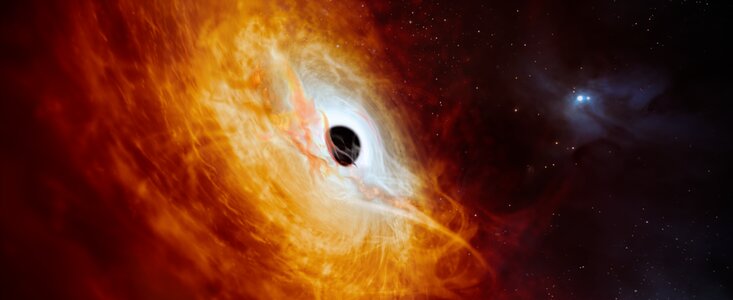Greetings, cosmic adventurers! Captain Nova here, back with another thrilling dive into the depths of the cosmos on Day 28 of our 100 Days of Space Exploration. Today, we set our sights on some of the most mysterious and powerful objects in the universe—Quasars. These celestial beacons shine with the intensity of a trillion stars, outshining entire galaxies and offering us a glimpse into the early universe. What exactly are quasars? How do they generate such immense energy? And why are they so crucial to understanding the cosmos? Let’s embark on this journey together!

What is a Quasar?
A quasar (short for “quasi-stellar object”) is an extremely luminous and distant celestial object powered by a supermassive black hole at the center of an active galaxy. Despite their small size relative to galaxies, quasars emit more energy than hundreds of billions of stars combined. Some quasars are so bright that they can be seen from billions of light-years away, making them some of the most distant objects we can observe in the universe.
Quasars were first discovered in the 1960s when astronomers noticed incredibly bright radio signals coming from seemingly “star-like” objects. But unlike stars, their light was redshifted, meaning they were much farther away than anything else previously observed.
What Powers a Quasar?
At the heart of every quasar lies a supermassive black hole—millions to billions of times the mass of our Sun. But how can something that absorbs light create one of the brightest objects in the universe? The secret lies in a phenomenon called an accretion disk.
- Feeding the Beast – As gas, dust, and stars fall into the black hole’s gravitational pull, they form a swirling accretion disk around it. This disk spins at incredible speeds due to the immense gravitational forces at play.
- Extreme Heat and Radiation – As material in the accretion disk spirals inward, it experiences friction and compression, heating up to millions of degrees. This extreme heat causes the disk to emit intense radiation, including X-rays and ultraviolet light.
- Relativistic Jets – Some quasars shoot out powerful jets of plasma at nearly the speed of light. These relativistic jets extend for thousands of light-years and are thought to be powered by the black hole’s magnetic fields.
This immense energy release makes quasars brighter than entire galaxies, allowing us to see them even at the edges of the observable universe.
How Far Away Are Quasars?
Quasars are some of the most distant objects astronomers have detected. The closest quasar, 3C 273, is about 2.4 billion light-years away. Most quasars, however, are found at distances of 10 billion light-years or more. Because light takes time to travel, observing quasars means looking far back in time, to when the universe was young—just a few billion years after the Big Bang.
This makes quasars cosmic time capsules, revealing crucial information about the formation of galaxies, black holes, and the early universe.
The Role of Quasars in Galactic Evolution
Quasars play a significant role in shaping galaxies. As they emit enormous amounts of energy, they can influence star formation, galactic structure, and even the distribution of matter in the universe.
1. Regulating Star Formation
The powerful radiation and winds from quasars can heat up and expel gas from a galaxy, preventing new stars from forming. This process, called quasar feedback, helps regulate the growth of galaxies and explains why some galaxies stop forming stars.
2. Merging Galaxies and Quasar Formation
Many quasars are believed to form when two galaxies collide and merge. These cosmic collisions funnel vast amounts of gas toward the supermassive black hole, igniting the quasar phase and making the galaxy shine brilliantly before settling into a quieter state.
3. Mapping Dark Matter and the Cosmic Web
Quasars emit light that travels across billions of light-years, passing through clouds of gas and dark matter. By studying how this light is absorbed, astronomers can map the large-scale structure of the universe, revealing how galaxies and dark matter are distributed across cosmic time.
Famous Quasars and Discoveries
Throughout the years, astronomers have discovered thousands of quasars, each providing a unique window into the distant universe. Here are a few famous ones:
- 3C 273 – The first quasar ever discovered, located 2.4 billion light-years away.
- TON 618 – Home to one of the most massive black holes ever found, estimated at 66 billion solar masses!
- ULAS J1120+0641 – One of the oldest known quasars, shining just 770 million years after the Big Bang.
Could the Milky Way Have a Quasar?
The Milky Way’s central black hole, Sagittarius A*, is not currently active as a quasar. However, evidence suggests it may have been a quasar in the past! Scientists have found traces of past high-energy activity in our galaxy’s core, meaning it could have once been much more energetic than it is today.
If our galaxy’s black hole were to suddenly start feeding on a massive amount of gas, it could briefly reignite as a quasar. But don’t worry—this wouldn’t pose a threat to Earth, as we’re located far enough away.
Why Quasars Matter
Quasars provide us with a unique glimpse into the past, helping scientists understand:
- How galaxies evolve over billions of years.
- The nature of supermassive black holes and their role in shaping the cosmos.
- The large-scale structure of the universe, including the distribution of dark matter and intergalactic gas.
Every quasar we study takes us one step closer to understanding the grand history of our universe.
Looking Ahead: The Milky Way – Our Cosmic Home
Tomorrow, we’ll shift our focus back to something much closer to home—our own galaxy, the Milky Way. How did it form? What mysteries lie at its heart? And where is it headed in the future? Join me as we explore the vast and beautiful galactic home we call our own.
Until then, keep your eyes on the skies and your curiosity alive!
Captain Nova
Odyssey Explore
Leave a Reply